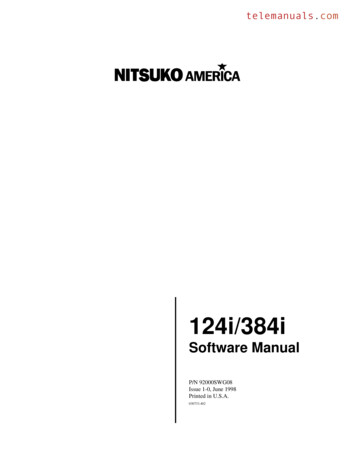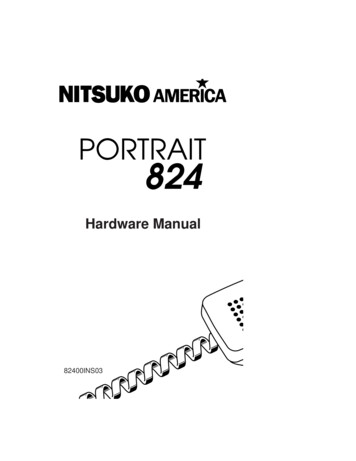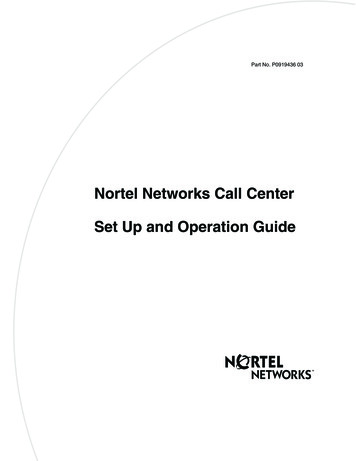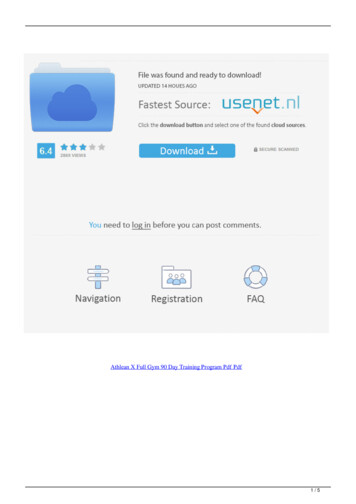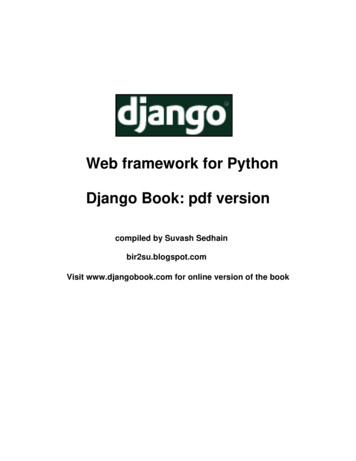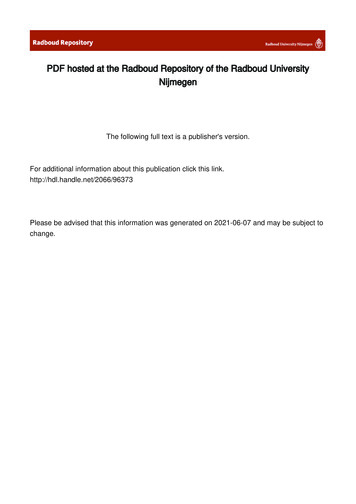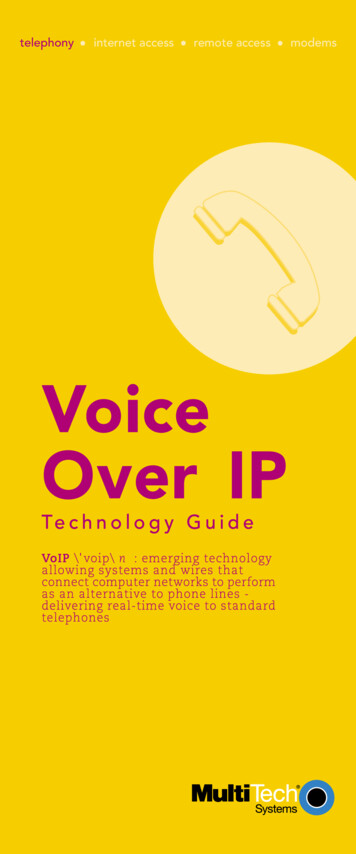
Transcription
telephonyinternet accessremote accessmodems
ContentToll-bypass Long Distance Calling . 1What Is VOIP? . 2That Was Then.This is Now.Immediate Cost Savings . 3Applications . 3Office-to-office CommunicationOff-net CallingCreate Off-premise ExtensionsReplace Expensive Tie LinesBusiness Quality Voice . 4Bandwidth Requirements . 5Interoperability . 5VOIP Solutions . 5RoutersVOIP Server CardsIP-based PBXPC-based TelephonyIP GatewaysThe Multi-Tech VOIP Solution . 7Easy to InstallLow-riskScalableEasy to UseRequirementsModelsTry VOIP Now! . 8VOIP Terms . 9
Toll-bypass Long Distance CallingNow multi-location businesses can use the Internet or aprivate network (Intranet) for long distance voice and faxcommunications and save thousands of dollars annually.Instead of paying your long distancecarrier to route long distancecalls between offices, any IPdata network can route thecalls using a technologycalled Voice over IP(VOIP). It doesn'tmatter if you areusing the Internet, aprivate Intranet,ISDN, DSL, framerelay, wireless, orsatellite for your datacommunicationsnetwork, as long as ituses the Internet Protocol(IP).If you make frequent long distance calls to a remote site,you already know the charges can add up quickly. Voiceover IP is designed to help you maximize the investmentsyou’ve already made in your data and telecommunicationsnetwork infrastructure by bridging them together toprovide toll-free communications.This guide provides telecommunication managers anddata communications managers with an introduction toVoice over IP and how they may benefit from voice anddata convergence.1
What is VOIP?VOIP lets you make toll-free long distance voice and faxcalls over existing IP data networks instead of the publicswitched telephone network (PSTN). Today businesses thatimplement their own VOIP solution can dramatically cutlong distance costs between two or more locations.That Was Then.For the past 100 years people have relied on the PSTN forvoice communication. During a call between twolocations, the line is dedicated to the two parties that areusing it. No other information can travel over the line,although there is often plenty of bandwidth available.Later, as data communications emerged, companies paidfor separate data lines so their computers could shareinformation, while voice and fax communications werestill handled by the PSTN.This Is Now.Today, with the rapid adoption of IP, we now have a farreaching, low-cost transport mechanism that can supportboth voice and data. A VOIP solution integrates seamlesslyinto the data network and operates alongside existingPBXs, or other phone equipment, to simply extend voicecapabilities to remote locations. The voice trafficessentially “rides for free” on top of the data network usingthe IP infrastructure and hardware already in place.2
Immediate Cost SavingsVOIP solutions provide the potential to save substantialamounts in long distance charges. Businesses with remoteoffices worldwide or just in a different area code milesaway can profit from a VOIP solution. Even with the mostinexpensive calling plans, a VOIP network, such asMulti-Tech’s MultiVOIP gateway solution, can quicklyreturn your investment and begin paying you back.LocationsMultiVO IPCos tCorporate Site/MinneapolisBranch Site/Los AngelesBranch Site/London 1,999MVP410(4 lines) 1,099MVP210(2 lines) 1,099MVP210(2 lines)Long k 0.0490139 days 0.0660153 days 0.0860115 daysIn fact, after the one-time investment is paid off, theVOIP solution begins to create profit for your company.ApplicationsVoice over IP is ideal for multi-location businesses lookingto reduce toll charges associated with intra-office calling.It is designed to help you maximize investments you’vealready made in your data and voice networkinfrastructure. Some examples of the many applicationsfor a voice over IP network include the following:Office-to-office CommunicationA VOIP network can be as small as two offices or as largeas hundreds of offices. Each office installs and configuresa VOIP solution on their network to begin placing calls orsending faxes to the other offices on the VOIP network.Off-net CallingTelecommuters or customers off the IP network can maketoll-free long distance calls by dialing into a local VOIPsolution and placing calls to any other location on theVOIP network. You can even have a VOIP solution at aremote site dial a local phone number for a free personto-person long distance call.3
Create Off-premise ExtensionsExtend the reach of your PBX into home office locations.Simply connect a VOIP solution to the PBX at thecorporate office, and another VOIP solution at the remoteoffice. Now, anyone can place calls to the remote officeby simply dialing an extension number.Replace Expensive Tie LinesA company that utilizes tie lines to connect branch officePBXs to the corporate PBX can now use their own IP-basedWide Area Network to complete the call.Business Quality VoiceIndependent tests of VOIP systems have shown that theyare perfectly capable of delivering “toll-quality” voice. Theactual voice quality your business will experience,however, is affected by a number of factors: WANbandwidth (the higher the better), voice compression andnetwork conditions such as latency (average “travel” timeit takes for a packet to pass through the network). On aprivate Intranet you can control all of these factors toachieve near toll-quality voice connections. When usingthe public Internet, you can control everything but thelatency factor. Latency, however, can be managed toenhance your voice quality with a quality of serviceguarantee from your ISP.When network traffic is at peak levels, voice can be givenpriority over data to ensureconsistently high voice“We made hundreds ofquality using thetest calls using theDifferentiated Services(MultiVOIP’s) outsidelines, and most people(DiffServ) Quality of Servicewe called couldn’t tell(QoS) protocol. Otherthat we weren’t on afeatures such as forwardstandard long distanceerror correction, bad frameline.”interpolation and dynamicjitter buffers, can further—PC Magazine Test Centerenhance voice quality.February 9, 19994
Bandwidth RequirementsOne common misconception about VOIP is that it is abandwidth hog, when, in fact, voice is a very efficient typeof traffic. Voice compression standards like G.729 (8:1)and G.723 (10:1) are used to minimize the bandwidthrequired for voice. G.723, for instance, is the maximumcompression rate and requires only 5.3K bps (plus anadded 7-8K bps for IP overhead). Even at maximumcompression, your VOIP solution will still provide neartoll-quality voice.As a rule of thumb, 14K bps of bandwidth per call is ideal.This includes the compressed voice packet and the IPoverhead. To determine total VOIP bandwidth needed perlocation, take the number of VOIP channels being usedand multiply by 14K bps. Then double this number toaccommodate for both voice and data traffic.It should also be noted that bandwidth is used only whensomeone is speaking. A silence suppression/VoiceActivation Detection (VAD) feature is an option that freesunused call bandwidth for data traffic. This is significant,since callers are usually silent for 60 percent of the call.InteroperabilityStandards are still emerging that ensure VOIP featureswork with different vendor solutions. The H.323 standardis the one most widely deployed and is the only approvedprotocol adopted by the International TelecommunicationsUnion (ITU). The H.323 standard provides support foraudio calls to other H.323 clients, gateways, gatekeepersand conference servers. Another emerging standard is theSession Initiation Protocol, or SIP. Look for products thatare adopting these two standards.VOIP SolutionsFrom the wide variety of VOIP solutions available today, theone you select depends on the size of your business, the levelof networking expertise available, the amount ofintegration with legacy equipment, and the level of voicequality you require.RoutersRouter solutions usually replace an existing networkrouter and keep voice and data all in a single box.However, this solution requires networking expertise, andcan be costly to install, while placing network services atrisk during deployment and maintenance.5
VOIP Server CardsVOIP server cards can be an economical VOIP solution.However, they must be compatible with the server andoperating system and installations can be complex.IP-based PBXThe IP-based PBX is usually software running on acomputer based server. However, it often requires aforklift upgrade of the existingPBX, or at a minimum, anextensive software and/orhardware upgrade. An IP-basedPBX is typically marketed tonew installations where nolegacy system is in place.PC-based TelephonyPC-based telephony software is by far the cheapest VOIPsolution, but it is also the clumsiest. It requires users tomake phone calls using their PC instead of a phone. Thisusually involves user training and an investment inspeakers and microphones for each PC. Plus, many userscomplain that voice quality for this solution is notadequate for business communications.IP GatewaysAn IP gateway, like Multi-Tech's MultiVOIP, is often themost suitable VOIP solution for small to midsizebusinesses and remote sites. It does not disturb yourexisting data infrastructure because it simply drops intothe Ethernet network. Furthermore, it operates alongsideexisting PBXs or other phone equipment to extend voicecapabilities to remote locations or users. An IP gatewayrequires only a minimal investment in product,installation, and user training.Planning a VOIP Implementation Encourage data communications managers andtelecommunications managers to work together. Choose a solution compatible with existing and plannedsystems. Ensure that the VOIP product utilizes industry standards(ITU G.711, G.729, G.723, H.323, SIP, etc.). Manage your bandwidth by giving priority to real-timetraffic, like voice and video. Keep VOIP calling as easy and seamless as possible byselecting a product that has calling proceduressimilar to your existing phones.6
The Multi-Tech VOIP SolutionMulti-Tech's award-winningMultiVOIP provides aneasy and low-risk wayfor your business tosave on long distancevoice and fax costs.Easy to InstallYou don't have to change your PBX, data network, orInternet/Intranet access to implement the MultiVOIPsolution. There is noMultiVOIP:integrating this device eliminates toll chargeswith a PC, a server, orbetween officesoperating system. Andto simplify installation,the central site canpreconfigure all unitsbefore sending them tothe remote sites. requires no changes tophone or networksystems installs in minutes easy to useLow-riskMultiVOIP allows you to implement VOIP withoutinterfering with your network infrastructure or phonesystem. If there are problems with the VOIP installation orthe IP network goes down, you can still pick up your phoneand use the PSTN to place a long distance call.ScalableThe MultiVOIP design allows you to expand VOIP supportas needed. Add more VOIP ports at a busy site withanother MultiVOIP. Add another office to your VOIPnetwork by installing a MultiVOIP at that office.Easy to UsePlacing calls with MultiVOIP is like using your existingphone system. No end-user training is required.7
RequirementsYou probably already have what you need to deploy aMultiVOIP network and start saving on long distance calls.MultiVOIP Site Requirements Ethernet LAN IP network IP addressesTo determine the number of ports that you need, firstdetermine what percentage of the long distance bill is usedfor intra-office communication (typically between 2540%), then multiply the percentage by the number of linesat the location. If you are using tie lines, for every linethat you support, you will need one port on the MultiVOIP.MultiVOIP ModelsModelDescriptionMVP1101-Port VOIP Gateway (FXS)MVP1201-Port VOIP Gateway (FXO)MVP2102-Port VOIP GatewayMVP4104-Port VOIP GatewayMVP8108-Port VOIP GatewayMVP241024/48-Port T1/PRI VOIP GatewayMVP301030/60-Port E1/PRI VOIP GatewayTo learn more about the MultiVOIP family visit our website at www.multitech.com/products/multivoip.Try VOIP Now!You be the judge! Call our toll-free demo (in the USA)1-877-TRYVOIP and hear for yourself how clearthe connection can be.8
VOIP Termsbad frame interpolation interpolates lost/corruptedpackets by using the previously received voice frames. Itincreases voice quality by making the voice transmissionmore robust in bursty error environments.compression is used at anywhere from 1:1 to 12:1 ratiosin VOIP applications to consume less bandwidth andleave more for data or other voice/fax communications.The voice quality may decrease with increasedcompression ratios.DiffServ (Differentiated Services) is a quality of serviceprotocol that prioritizes IP voice and data traffic to helppreserve voice quality even when network traffic is heavy.dynamic jitter buffer collects voice packets, stores them,and shifts them to the voice processor in evenly spacedintervals to reduce any distortion in the sound.E&M (Ear and Mouth) is the interface on a VOIP devicethat allows it to be connected to analog PBX trunk ports(tie lines).forward error correction increases voice quality byrecovering lost or corrupted packets.FXO (foreign exchange office) is the interface on a VOIPdevice for connecting to an analog PBX extension.FXS (foreign exchange station) is the interface on a VOIPdevice for con
for intra-office communication (typically between 25-40%), then multiply the percentage by the number of lines at the location. If you are using tie lines, for every line that you support, you will need one port on the MultiVOIP. MultiVOIP Models To learn more about the MultiVOIP family visit our web site at
